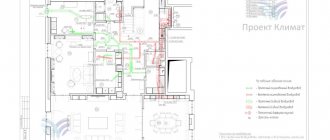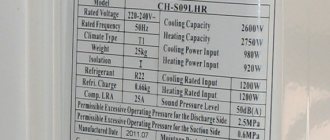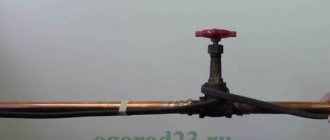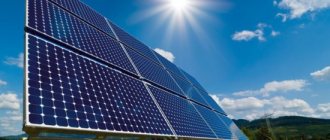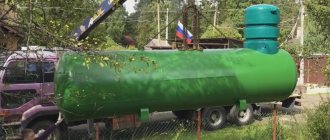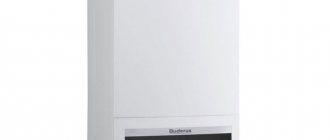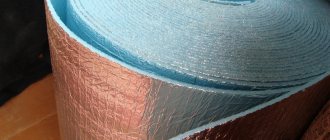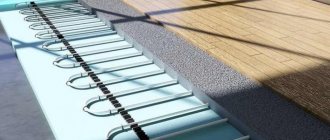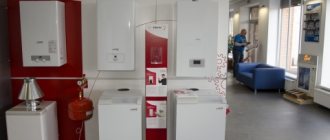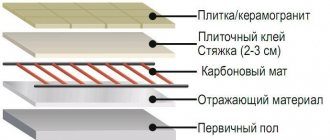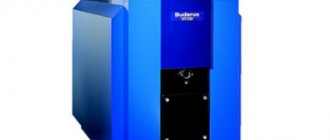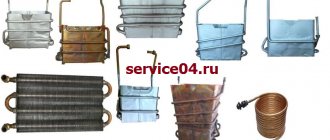Is it possible to use air conditioning in an apartment in winter?
To work at high negative temperatures “for cooling”, you can install the so-called “winter kit”. Its task is to heat the drainage and compressor crankcase; adjust the condensation temperature. Some (more expensive) air conditioners already have all the options to operate at sub-zero temperatures. This is relevant for rooms in which there is constant, year-round heat generation (server rooms, stations, etc.)
Is it possible to turn on the air conditioner for heating in winter?
Based on the above, the split system can be turned on “for heat” above 0 degrees Celsius (unless a different value is set by the manufacturer or an additional kit is installed). This limitation is provided to prevent icing of the fan and condenser of the outdoor unit. In addition, with a further decrease in temperature, the efficiency of the air conditioner (efficiency) decreases significantly.
Operating principle
If you are interested in the intricacies of installing a winter kit on an air conditioner, instructions and setup rules, you need to fully understand the principle of operation of the equipment, which is based on simple physical laws: thermal energy is absorbed during evaporation, and released during condensation.
We recommend that you read: Column air conditioners
Initially, the system was used only for cooling purposes, but advanced modern technologies have reached such a level of development that climate control technology is quite suitable for heating rooms.
If we talk about the cooling principle, it consists of the following stages:
- The refrigerant in the gas state enters the compressor, where it is compressed under pressure and begins to warm up to high temperatures.
- Then from the compressor the substance enters the condenser, turning into a liquid state.
- As the pressure decreases, the refrigerant enters the evaporator in the indoor unit, where it returns to its original state. As a result of such processes, it boils, “taking away” the thermal potential from the room and traveling back to the external unit. Ultimately, the resulting heat is “thrown out” outside.
- When the working substance in the gas state returns back to the compressor, the cycle is completed.
To use this principle for the opposite task - heating a room, it is necessary to use a special valve. This element rotates the flow to supply warm air masses and remove cold ones.
Operating principle of household climate control equipment
The operating modes of the air conditioner, which are responsible for heating and cooling the room, operate thanks to the refrigerant, which serves as a conductor between street and home heat. In other words, household split systems themselves cannot reproduce it, but as pumps they only pump warm air into the room from the street and vice versa. Heat transfer occurs through special types of freons, and air exchange between them and the environment is carried out by air heat exchangers.
In this case, the heat performance depends both on the design of the heat exchanger, which is different for certain models of air conditioners, and on the initial temperature of the air that is passed through it.
The compressor, located in the outer casing of the device, is responsible for distributing the refrigerant throughout the device. The oil helps him with this, as it begins to thicken in the cold. As a result, the compressor mechanism operates without lubrication, and its spare parts wear out ahead of time.
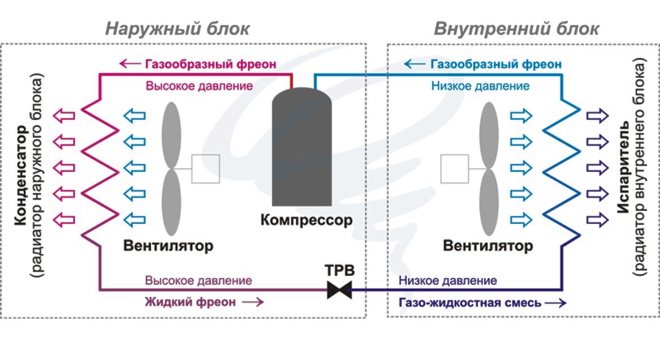
Operating principle of the air conditioner
There are certain rules for operating an air conditioner in winter, failure to comply with which will lead to its breakdown, and this is often caused by water hammer. When the heating mode is turned on, the freon is heated and evaporates, however, due to excessively low temperature indicators, it does not have time to do this and the liquefied one penetrates the compressor valves.
Ambient temperature and humidity are interconnected - when one indicator changes, the other automatically changes. As a result, the volume of condensate released by the split system increases. It is removed from the device through a special drainage pipe, which, when the temperature drops greatly, becomes covered with ice inside. The condensation has nowhere to drain and it either begins to ooze out from the internal housing, or completely renders the air conditioner unusable.
It is permissible to use a household climate control device in winter, when the operating instructions for the air conditioner allow it, but in the meantime, observing all the precautions specified in it.
general information
There are various types of air conditioners available for sale, which differ in their operating properties and operating principles. However, many of them are used only during the warm season, and with the arrival of winter they are turned off.
This is due to the likelihood of condensation occurring inside the equipment due to the effects of temperature and humidity. Modern models of air conditioners are equipped with a powerful drainage system that removes remaining moisture using a special pipe led outside. If temperatures drop below freezing, the tube can become severely frozen, causing an ice block to form. In the future, it will be impossible to remove the condensate outside, which will lead to one of two scenarios:
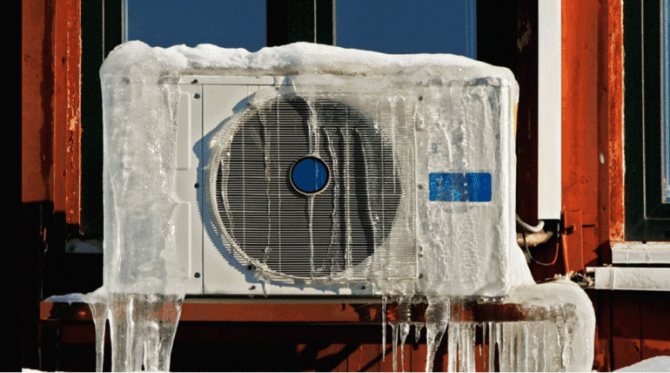
- Remaining moisture will enter the room, causing the appearance of fungi, mold and dampness.
- Condensation will damage the system.
Exposure to cold is dangerous not only for the internal elements of the air conditioner, but also for the external ones. The compressor, which compresses the working substance that ensures the normal functionality of the device, is at risk of damage and is responsible for its circulation throughout the entire circuit. For balanced operation of the equipment, you need to use a special oil composition, but under the influence of negative temperatures it becomes very thick, and system parts begin to wear out.
When the heating mode is started, the refrigerant should not be cooled, but heated. Otherwise, the heating functions deteriorate and the system is subject to failure. Therefore, the operating mode of the air conditioner in winter is significantly different from summer.
But there is a unique type of device that is suitable for working in cold conditions. This is a mobile monoblock air conditioner, which is a mobile unit with small dimensions and good efficiency indicators. It can be transported to any room or taken to the dacha without performing complex installation. The key components of the device are located indoors, with the exception of the air duct for removing warm or cold air masses. To prevent the risk of condensate freezing during severe frosts, the pipe is connected to a ventilation shaft.
Choosing a split system with heating function
When choosing a heated air conditioner, you must consider the following parameters:
- power consumption of electricity;
- thermal energy productivity;
- energy efficiency category;
- range of permissible operating temperatures;
- automatic defrosting mode of the condenser in the outdoor module.
There are also several other aspects that should be kept in mind when operating an inexpensive air conditioner in heating mode: the purpose of the room (residential, industrial); room dimensions. For example, if this is a production workshop in which there are a large number of workers, then much less energy consumption will be spent on heating. Consequently, the efficiency will be close to the best value.
If you need to choose a split without built-in heating, then it is better to choose inverter air conditioners with winter components, since they are designed to operate in an extended range of sub-zero temperatures.
Operating an air conditioner as a heater
All questions about the advisability of using a winter set will disappear by themselves if you understand exactly how the air conditioner heats the room.
This device is fundamentally different from electric heaters such as fan heaters, convectors and oil radiators. They simply convert the energy of electric current into heat by inserting a conductor with high electrical resistance into the circuit. How warm is it there, one of the readers will ask, if icicles are about to appear on the roof?
Indeed, according to our feelings, the air outside on the eve of winter is quite cold.
But even this, although this, at first glance, contradicts common sense, can act as a source of thermal energy.
Such sources are called low-potential. The remarkable property of gases to change their temperature depending on pressure helps to take away thermal energy from them. Let's do a mental experiment:
- Let's take a certain vessel, the volume of which can vary, and fill it with any gas. Let it be something like a plugged syringe with a plunger.
- Going outside, let’s increase the volume of the vessel. The gas will cool down. If you correctly select the volume of the vessel and the gas, then its temperature will be lower than the temperature of the outside air, even if it is almost frosty. Due to the temperature difference, heat exchange will begin - the gas in the vessel will begin to heat up.
- Returning to the room, we reduce the volume of the vessel by compressing the gas in it. The temperature of the latter will immediately increase and become higher than that of the air in the room, even if it is relatively hot there. Heat exchange will begin again, only in the other direction - thermal energy will be transferred from the gas to the environment.
Repeating cycle after cycle, we will heat the room using cold outside air. To enhance the effect, the gas and volume of the vessel should be selected in such a way that its state of aggregation changes during heating and cooling. Indeed, during evaporation, the liquid absorbs much more heat than simply when heated with the same temperature difference. Accordingly, during condensation, the gas gives off much more heat than simply when cooling with the same temperature difference.
Let us explain with an example: when water vapor cools from a temperature of 120 degrees to 90 (it condenses), much more thermal energy is released than when it cools from 150 degrees to 120 - that is, by the same 30 degrees.
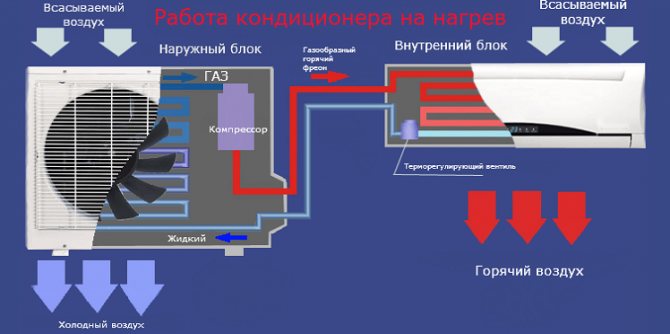
The principle of operation of an air conditioner for heating
The air conditioner operates in heating mode according to the described principle. Only instead of one vessel, which would have to be moved from inside to outside and back, two are used (they are called heat exchangers), one of which is always located indoors, and the second outside.
Gas flows from one heat exchanger to another and back through pipelines. Another difference: the pressure of the gas (called refrigerant) increases not by reducing the volume of the vessel, but by pumping it with a compressor.
After getting acquainted with the principle of operation of the air conditioner, the following conclusions become obvious:
- The heat produced by an air conditioner is essentially free. Of course, to obtain thermal energy you need to spend electrical energy (mainly to operate the compressor), but in a ratio not 1:1, as is the case with electric heaters, but 1:3 or even 1:4. That is, for 1 kW of electricity spent we get 3 - 4 kW of heat.
- The heating performance of the air conditioner depends on the outside temperature. If it reaches a certain minimum value, which is determined by the physical properties of the refrigerant used and the design of the device (mainly the volume of heat exchangers), the outflow of heat from the outside will stop.
In the main mode - cooling - the air conditioner operates on the same principle, only with the help of a special 4-way valve the direction of movement of the refrigerant changes in such a way that its compression with condensation occurs in the external heat exchanger, and evaporation with expansion in the internal one. In this case, there is an outflow of heat from the room to the street.
Minimum temperature
At what temperature can the air conditioner be turned on for heating? – there is no clear answer to this question. It all depends on the model and manufacturer. Some models can operate for heating at -10, and some only at +5.
Inverter air conditioners have a lower minimum operating temperature. than non-inverter ones. Below is a table of minimum temperatures for the most popular air conditioner models (we replaced the model power with the ** symbol):
| Air conditioner model | Minimum temperature for heating operation |
| Cooper&Hunter CH-S**FTXLA | -25 |
| Toshiba RAS-**U2KH3S-EE / RAS-**U2AH3S-EE | -5 / -10 |
| Mitsubishi Electric MUZ-FH**VE | -15 / -16 |
| Panasonis CS-HE**QKD/CU-HE**QKD | -15 / -16 |
| Midea MSR-**ARDN1 | |
| DAIKIN FTXB20/RXB20 | -15 |
Air conditioning for heating in winter
It is traditionally believed that heating a room with air conditioning in winter is the destiny of warm countries, where the minimum temperature in January is -5C. The opinion “the air conditioner cannot be turned on in winter” is spread by the sellers and installers themselves, because the manufacturers’ catalogs actually indicate the minimum operating temperature of the air conditioner in winter down to -5C. But how objective is this?
Is it possible to turn on the air conditioner in winter?
Up to the minimum temperatures specified in the manufacturer's documentation - of course it is possible. It’s not just that manufacturers add the ability to operate the air conditioner for heating in winter, the so-called. heat pump function.
What air conditioners can be turned on in winter?
Any, but up to the temperature indicated in the passport, usually -5C. If you want to turn on the air conditioner for heating in winter at lower temperatures, you will need to modify the air conditioner to operate in winter, the so-called winter package for the air conditioner.
At what temperature can you operate your air conditioner in winter?
When the outside temperature is above -5C, additional preparation of any air conditioner for winter is not required. For most inverter split systems, the lower threshold for heating the air conditioner in winter is usually -15C.
Does a semi-industrial air conditioner work in winter at 30?
Semi-industrial models are also split systems, differing in the type of indoor unit, improved compressor, increased heat exchanger area and additional protective functions. Therefore, they can withstand extreme winter loads more easily and lose less performance at low temperatures compared to household series. The only thing that can prevent a semi-industrial air conditioner from working for heating in winter is the built-in electronic protection for outside temperature on some models. In each case, you need to look at the documentation for this block.
Is it possible to heat with air conditioning in winter?
Yes, almost all modern models have this feature. The air conditioner in heating mode in winter works like an air heat pump, i.e. "Air conditioner in reverse." The outdoor unit “takes heat” from the street air and releases it into the room. But the lower the street temperature, the lower the efficiency (after all, there is less heat in the street air). Even an inverter air conditioner in winter produces efficiency > 1 only up to temperatures of -15C/-17C. It can work at lower outdoor temperatures, but the efficiency will be comparable to a conventional heating element.
Air conditioners with heating in winter up to 25
Special series of winter split systems with a factory low-temperature set are produced, for example, the General Nordic series from the Japanese manufacturer Fujitsu General. Developed for Scandinavia, it normally produces an efficiency of >2 down to -25C. But such winter split systems are more expensive than conventional inverters.
To what temperature can the air conditioner be turned on in winter?
If the outdoor unit is installed outdoors, but modified with a “winter air conditioning package,” then it can be turned on down to -30C, although the efficiency of the system at temperatures below -15C will not be higher than 1:2 (depending on the model).
To use the air conditioner for heating in winter at any outside temperature, the outdoor unit can use the heat lost by the building through the building envelope or exhaust ventilation.
Heating with air conditioning in winter: pros and cons
It is possible to use air conditioning in an apartment in winter, but if there is central heating, it is hardly advisable. In apartments, they usually turn on the air conditioning for heating only in the off-season, when the temperature outside is close to zero, and the central heating is not yet turned on.
A private house is a different matter. With proper design and installation, an air conditioner can become the main source of heating for a home.
Benefits of using an air conditioner in winter for heating:
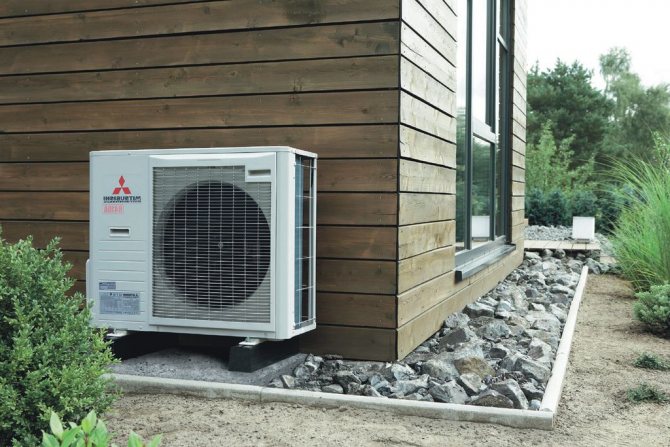
1) Energy saving. The average energy efficiency ratio for the heating season is 1:3. This means that the air conditioner will consume three times less electricity compared to heating with heating elements or an electric boiler. For energy-scarce areas this can be critical.
2) Safe coolant. A power outage in a house with an electric boiler will lead to defrosting of pipes and expensive repairs to the heating system.
3) Fire safety. Freon from air conditioners is non-flammable, and even if the pipes are depressurized, the house will not be damaged.
4) Remote control. All modern Japanese air conditioners support the ability to control via the Internet (using additional devices), as well as maintaining a temperature of +10 to save energy when heating country houses.
5) Air conditioning in summer. In the summer, you also get a home cooling system at no additional cost.
Of the minuses, we can name only one – the price, compared to simple gas boilers. But if there is no gas in the village and there are limits on electricity, then there is no alternative to air conditioning for heating in winter.
Heating with air conditioning in winter - personal experience
Well-known freelance journalist Viktor Borisov has been blogging about building a house with his own hands for several years.
He chose a Mitsubishi Heavy Industries ducted inverter air conditioner as the only heating system. In his blog, he shares in detail his experience of operating an air conditioner in winter for heating for four years (https://victorborisov.livejournal.com/281859.html).
Some of the comments from “air conditioning specialists” are especially annoying. As often happens in life, people are not interested in facts that contradict their picture of the world.
Heating efficiency
The split system may not always be able to operate at full capacity in cold weather. For example, the specification states that it can operate down to -20. This does not mean that the air conditioner will warm the air to +24.
As a rule, at a minimum temperature the air warms up no higher than +16...+18 °C. The colder it is outside, the worse the air conditioner works.
Each air conditioner has a COP (Coefficient of performance). This is analogous to efficiency. The higher it is, the more economically the equipment operates. For example, at COP 3, for every 1 kW of electricity you will receive 3 kW of heat.
The greater the difference in temperature outside and in the apartment, the lower the COP and the worse the air conditioner works for heating.
Exploitation
The main thing is to clean the split system before the cold season. Particular attention should be paid to the outdoor unit - because it is affected by frost and cold. If you wish, you can do it yourself. Read more in the article “How to clean an air conditioner yourself.”
There is no big difference between operating an air conditioner in winter and summer. You just need to turn it on and monitor the condition of the outdoor unit. It freezes up over time, causing the air conditioner's performance to deteriorate.
Air conditioning cooling in winter
Some rooms require constant cooling because they contain expensive equipment. As already mentioned, most often these are server rooms that have high heat transfer. When temperatures rise in summer, equipment can fail and disrupt the operation of the entire enterprise.
Similar equipment are magnetic resonance imaging scanners in hospitals. These devices cost several hundred thousand dollars and are very expensive to install and repair. The purpose of the air conditioner is to protect the MRI machine from breakdown, so it must work for cooling in both winter and summer. In summer there are no problems, but in winter you need to install heating for climate control equipment and observe the temperature regime.
In areas with harsh climates, it is better not to skimp on cooling electronic diagnostic equipment, since repairs will cost more than the most expensive model. The best are Japanese split systems, which turn on at temperatures down to minus 25 degrees, and with a winter set up to minus 30.
Several cooling systems are installed in special rooms so that if one fails, a spare one can be turned on.
Installation procedure
The winter kit is mounted on the external module. This allows you to use the air conditioner for cooling in cold weather (up to – 30°C).
To connect the kit to the external module, you must dismantle it, remove the outer and side covers, and the front panel. After this you can proceed to the connection:
- compressor crankcase heating devices;
- temperature sensor with its connection to the fan;
- cable for heating the drainage tube.
Upon completion of all connections, the previously removed housing elements are returned to their place, and the unit is placed on the brackets.
Winter set
It is a combination of several devices:
- Drainage system heater. Heats up the communications so that the discharged liquid can pass through the pipes without hindrance.
- A device that heats the compressor crankcase of the external unit. Helps warm up the inactive compressor, so the latter starts up already warm, the oil is liquid, and the freon is cooled.
- A device that reduces the fan rotation speed to normalize the efficiency of the device (relates to the cooling function; when heating, the fan should rotate faster than usual).
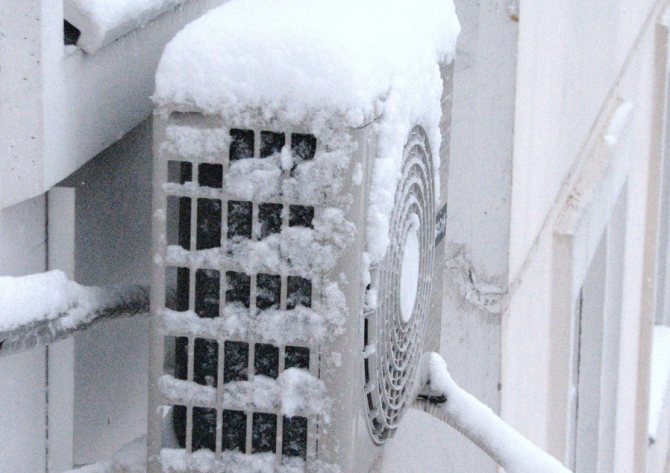
Installing the kit on a device with a heating option will not help the air conditioner function properly in winter. Such equipment will only be correct in the case of cooling operation.
Equipment modifications equipped by manufacturers with a winter kit and an anti-icing program are also ineffective in winter, despite the specified temperature ranges. Only a small part will work in cold weather. Semi-industrial models are capable of heating.
Installation and connection of the winter kit

Before moving on to the issue of installing and connecting the winter kit to the air conditioner, it should be noted that it was initially provided for on/off models. In inverter systems, there is no need for a control board, since the variability of fan speed changes is already built into the control module of the external unit. They only require heating of the drainage and compressor crankcase, that is, installation is assumed in a truncated version. Any installation and commissioning work begins with studying the circuit diagram for connecting a winter kit to an air conditioner, which can be found in several places. For most devices, it is printed on the variator board or placed in the installation instructions for the winter package, which is included with the device itself.
Peculiarities
The schematic diagram cannot be the same for everyone, therefore, in each individual case, use the option recommended for a specific model.
Why is that? There are many nuances here. The fact is that split systems operating only on cold do not have a four-way valve, so the process is simplified. In devices operating in heat pump mode, this element is present, which somewhat complicates the installation and connection of the kit to the air conditioner. Depending on the number of fan speed modes, installation can occur either with a phase break or with a neutral break. Some fans have a minimum speed setting that corresponds to the lowest possible speed, so installing a fan speed controller may not be practical.
Compressor crankcase heating and rotation regulator
temperature sensor
So, installing a winter kit on an air conditioner begins with disassembling the casing of the outdoor unit. First, the module is dismantled, then the protective and top covers are removed from the service ports and the front panel is removed.
First of all, the compressor crankcase heating is attached. It is placed on the lower part of the crankcase so that the oil is heated more efficiently. It is necessary to ensure the presence of constant voltage. This will eliminate the possibility of cold starts and oil foaming. Then the rotation regulator is connected to the open circuit of the fan. For start-stop models, this usually requires individual power supply. It is taken from a separately laid wire.
connecting the regulator
The fan retarder has a temperature sensor. It is installed on the condenser coil, located in the middle 1/3 of the upper part of the heat exchanger in the direction of freon movement. Here their optimal contact occurs, ensuring an accurate determination of the condensation temperature. The variator itself is installed and powered, focusing on the circuit diagram for connecting the low-temperature kit to the air conditioner, while it is better to fasten its wires with plastic clamps - this will put less load on the terminals.
After connecting the power, the external unit is assembled, ensuring that all elements are securely secured in their original places. The wires are connected into one assembly with clamps, trying to secure them so that they do not come into contact with the body of the device and the connecting lines of the two blocks. Be sure to check the functionality of the regulator by first starting the air conditioner in cooling mode, and then in heating mode. Readings are taken with a pressure gauge or thermometer.
Drainage heating
Then install the drainage heating, securing it with plastic clamps to the drainage hose, and energize it. As a rule, if the external unit of the air conditioner does not have a power terminal, then an additional power cable is laid along with the interunit cable. If there is a supply terminal, drainage heating, as well as compressor crankcase heating, is powered from it.
At the end of the article, an approximate connection diagram for the winter kit will be given, which is suitable for on/off models. For inverter split systems, equipment is first diagnosed and only then installation is carried out according to a suitable scheme. Some manufacturers produce air conditioners that are compatible with winter sets only of the same brand.
After all installation stages are completed, you can put the air conditioner into operation, but for reliable operation in winter, external protection of the outdoor unit must be provided. In a private house, it can be placed in the space under the balcony, and in an apartment building, the device is hidden under a special canopy that blocks direct access to precipitation.
At what temperature can and cannot be turned on?
The best option would be to use an air conditioner during the winter season at temperatures from 3 to 10 degrees.
In this case, the device will be able to show maximum performance when consuming 3 kilowatts of electricity (approximate number). If the outside temperature drops below 0, equipment performance drops. The compressor wears out and air begins to be pumped incorrectly. However, all devices have their own permissible technical temperature limits when they can be used. For example, the instructions may indicate that compressor wear will occur at a temperature of -15 degrees. It will be possible to turn on the device when the reading is not lower than -12 degrees. This point should be understood when purchasing a foreign or Russian-made device for your home.
How many degrees can the air conditioner be turned on?
Typically, the air conditioner operates in heating mode when the air temperature exceeds -5 degrees. If there are lower temperatures, then the heating system cannot be used due to the process of reducing the power of the system, breakdown of the drainage and the risk of condenser icing and subsequent repair of the inverter.
But some split models are capable of heating air at temperatures of -10 and -15 degrees. At the last mark, inverter-type models can heat the house. They are adjustable, so they are more flexible to temperature changes.
In general, it can be stated that turning on the air conditioner in winter should be done with caution in order to heat up, following the operating instructions. It is better not to use the system if the thermometer shows the critical point declared by the manufacturer.
You may be interested in: How to dismantle an air conditioner without losing freon
Rate the articlePhotos for the article are taken from Yandex.Images
Add a comment Cancel reply
Name *
Email *
A comment
Save my name, email, and website in this browser for the next time I comment.
Navigation
- Refrigerators
- Car refrigerators
- Wine cabinets
- Mini refrigerators
- Freezers
- Thermal containers
- Thermal bags
Recommended Refrigerators Single chamber refrigerator without freezer 06
Refrigerators Narrow refrigerator up to 50 cm. Compact but roomy 06 Refrigerators Storing potatoes in the refrigerator 09 Freezers liebherr chest freezer 09You may also like

Why may an air conditioner or split system fail to heat? Due to various circumstances, air conditioners stop working024
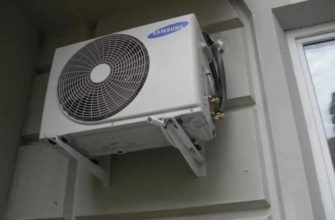
The design and principle of operation of the air conditioner The invention of the air conditioner allowed people to feel032
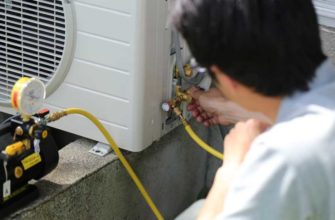
How to dismantle an air conditioner without losing freon Since very often many people move or change017
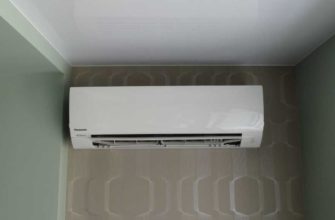
Errors in air conditioners of different models Many Russians have air conditioners at home.013
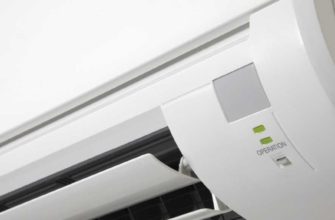
Drying function in an air conditioner The functionality of modern air conditioners allows035
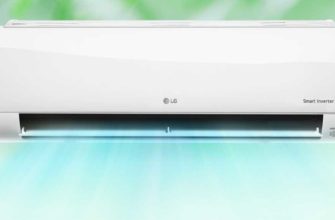
Features of an inverter air conditioner If the house is hot in the summer, but damp and dank in the fall and spring016

Disassembling the air conditioner The air conditioner is an important device for ensuring favorable021
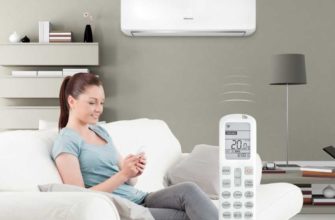
Features and selection of air conditioner power For efficient and fast cooling of space09
- Contacts
- Site Map
- Refrigerators
- Air conditioners
- Thermal bags
- Freezers
- Mini refrigerators
- Thermal containers
textarea>
Differences in the design of frost-resistant air conditioners
Why can one air conditioner be turned on at 30 degrees below zero, while it is undesirable to start others at -50C? The answer is simple: structural features and configuration. The cost of a split system is not always directly proportional to its capabilities, and therefore it is useful to know what effective design solutions exist.
To understand whether it is possible to turn on a particular air conditioner for heating in winter, or whether this is dangerous for the device, pay attention to such details.
Firstly, a low temperature kit should be built in from the factory to prevent cold starts of the compressor and condensate freezing.
Winter air conditioner kit
Recently, more and more often you can find proposals for equipping an air conditioner with a winter kit. Sellers of this equipment assure that its installation will make the air conditioner an effective heater throughout the winter, even in frosty weather. Whether this is so - we will figure it out.
Components of a winter work kit
A low-temperature kit, as a rule, includes 3 components: a heating pan, a compressor crankcase and a fan speed controller. Sometimes there is also a temperature sensor and a control board - separate for each component or common to all.
Heating the pan is necessary to prevent the condensate draining from the radiator from freezing when the defrost mode is turned on.
The crankcase heater is a wire or plate that surrounds the compressor in the place where oil accumulates.
It is advisable to turn on the compressor heating before starting the air conditioner so that the oil has time to warm up. In practice, heating often occurs either only during operation or only during idle time. Only the second option will ensure safety for the compressor, but it is less profitable due to increased energy consumption.
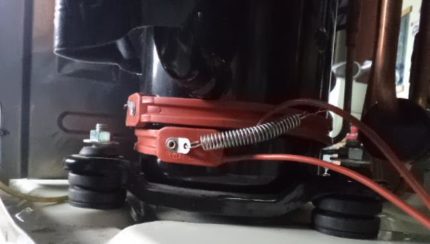
Thanks to crankcase heating, you can avoid cold starts and operation of the compressor when the lubricant has thickened in the cold, which means increased load during startup and wear of moving parts
Adjusting the fan speed determines the activity of heat exchange between freon and the external environment: the stronger the air flow, the more heat is transferred. When working for heating, this is not critically important, because maximum heat transfer is needed, and high fan speed is set from the factory.
It’s another matter if the air conditioner operates for cooling at temperatures below +14 – +180 allowed by the manufacturer. Then the freon can give off too much heat, and the indoor unit will begin to freeze: it will become covered with frost and ice, and the condensate will freeze. To prevent this from happening, the fan is slowed down.
Is it advisable to install a winter kit?
After installing a low-temperature kit, the owner may have a question: is it now possible to heat the room with an air conditioner at low outside temperatures? The answer is yes, you can, it is now safe for the air conditioner. The exception is unqualified installation or home-made equipment.
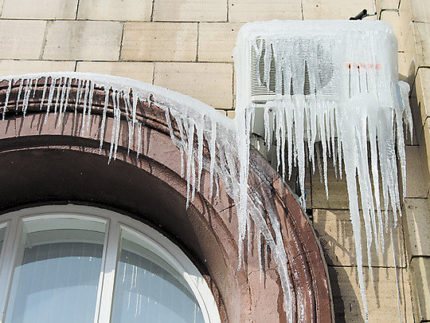
If there is dripping from the roof on the air conditioner and therefore huge icicles form, a winter kit will not help - you need a protective visor
Is it effective? Air conditioning heating is valued for its efficiency: its efficiency can reach 3 – 5 and even 7, depending on the model. This is achieved by the fact that the split system is the only heater that does not produce heat. The compressor and fans require much less energy to operate than the system can move into the home.
The declared efficiency, or, as the manufacturers write, COP, is relevant when operating for heating at +70 outside. As it gets colder, the temperature difference between air and freon decreases, which means heat exchange worsens and the efficiency of the air conditioner decreases.
At temperatures below -150C, the efficiency of the air conditioner decreases to approximately 1%, that is, for every kilowatt of electricity consumed, only 1 kW of heat can be obtained. Conventional convectors or infrared heaters, which are cheaper and do not depend on the outside temperature, also have such indicators.
Of course, these calculations are approximate; the result greatly depends on the model of the air conditioner, the low-temperature set, and even the connection diagram of the second one. But the fact is that the lower the temperature outside, the less effective and economical heating with a split system is.
Considering that the cost of a good winter kit for turning on heating with an air conditioner with installation can be 40 - 150% of the cost of the air conditioner, and it will work effectively only down to -150C, the feasibility of the purchase is very controversial.
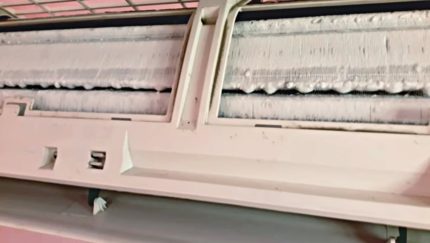
When the air conditioner operates for cooling in winter without a low-temperature set, frost and an ice crust forms on the indoor unit
How to install a low temperature kit
Installation of additional options should be carried out by an experienced specialist, since incorrect connection can lead to serious damage.
The low temperature kit, as it is also called, is universal for all non-inverter air conditioners. But for most inverter models, a regulator is not required, and the main manufacturers of split systems offer their own additional options for operating at low temperatures. Of course, it is more convenient to install the winter kit on a removed external unit, since full access to it is required. In this case, its body is disassembled and the connection is made:
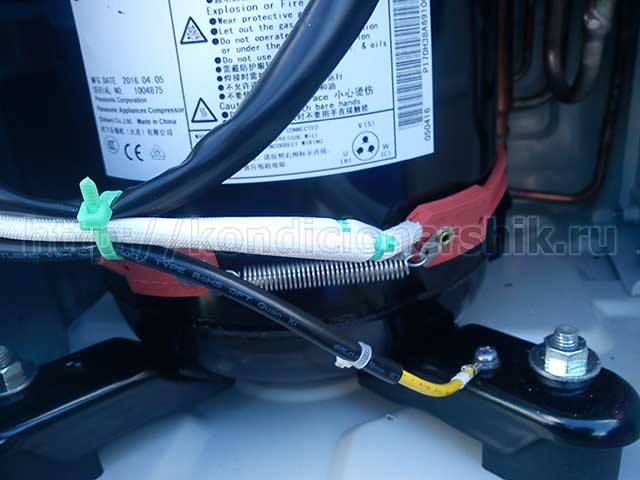
We put the heating element on the compressor crankcase approximately 5 cm from the bottom. We connect its power, preferably through a thermostat, or install a separate machine.- We screw the pressure regulator block onto the free wall of the housing closer to the connecting blocks of the external unit so that there is access for its adjustment. We connect the regulator according to its diagram. We connect its load “into the gap” of the fan control wire. We connect the additional regulator wire to the four-way valve control wire. We connect the “power supply” of the regulator. Next, you need to correctly install the temperature sensor on the radiator (heat exchanger) to accurately determine the temperature. The entire operation of the regulator will depend on this operation. The sensor should be located on the middle “roll” of the radiator (we determine visually the middle of the heat exchanger). We fasten the sensor using a clamp (for thermal contact it is better to use thermal paste and thermal insulation).
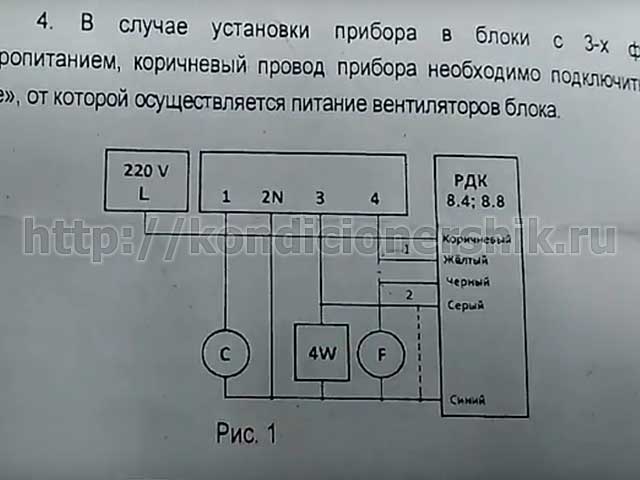
The drainage should go outside separately from other communications (i.e. we drill a separate hole). At the drainage outlet, you can use a copper tube, to which we attach a heating element with electrical tape. It is also possible to use a heater with a metal-plastic tube in a thermoflex.
There are many different winter packages available these days. They come with detailed instructions to help you make the connection. I hope that our article was useful to someone!
If you have something important to add regarding the winter kit for air conditioners, then write in the comments!
Consequences of operating the system at prohibited temperatures
If, when operating climate control equipment, you ignore the manufacturer’s recommendations on the maximum permissible temperature values, critical breakdowns are possible. Why it is impossible to use systems that are not intended for operation in winter is additionally indicated by the manufacturer in the precautionary measures. Here's what happens if you don't follow the restrictions:
- reduction in the efficiency of equipment up to shutdown;
- icing of the external and internal units;
- thickening of oil in the refrigerant;
- excessive friction of parts without lubrication;
- the appearance of ice in the drainage tube;
- leakage of condensate into the living space;
- broken fan blades;
- Compressor wear and breakdown.
Important! Most split systems are designed to operate in average annual temperatures. They can be used as additional heating in the off-season, until the main heating source is turned on, but no more.
Cooling work in winter
Typically, an air conditioner is not used to cool room air in winter. In winter, it is necessary to heat the premises more than to lower the temperature in it. Nevertheless, it can and will work in this mode with a slight minus outside the window. There are just a few points.
Restrictions on the use of a household air conditioner in winter when there is too much frost are due to the fact that:
- In the compressor of the external unit, the oil begins to thicken due to low temperatures, sometimes until it completely solidifies.
- The drainage (hose with dripping water) may simply freeze.
In both cases, the equipment will inevitably break. At the same time, the temperature outside the window “near zero” is not scary for most air conditioners. It is quite permissible to turn them on “in the cold” in winter. It is only recommended not to do this too often. On the one hand, due to the thick, frozen oil, the compressor operates with overload after switching on, and on the other hand, its efficiency at minus temperatures outside leaves much to be desired.
Even if ordinary household air conditioning appliances are designed to work in winter, they still cannot function as efficiently as in summer. If there are drops outside the window, then you can use it occasionally in case of urgent need. But it’s better not to find out in practice what will happen if you turn on the air conditioner constantly for cooling in winter. It won't last long.
Turning on the air conditioner in winter for cooling
Considering the fact that most air conditioners operate on a similar principle, it is prohibited to use climate control equipment for cold temperatures at low temperatures. Thus, you can turn on cooling in winter only if the temperature corresponds to the range established by the manufacturer. In most cases it is not lower than -5 degrees.
If cooling is required at sub-zero temperatures below 5 degrees, for example, for server rooms, a special system is needed . Otherwise, the air conditioner will fail - the compressor will simply overheat and burn out. Specific information should be clarified directly in the instructions for use of the individual device.
Heating process
The presence of a room heating function using an air conditioner is considered a kind of know-how in the world of climate control equipment. But it is extremely useful for those regions where cold weather can begin suddenly and long before the centralized heating system is turned on. During the so-called off-season, the problem of a rapid decrease in air temperature manifests itself particularly intensely.
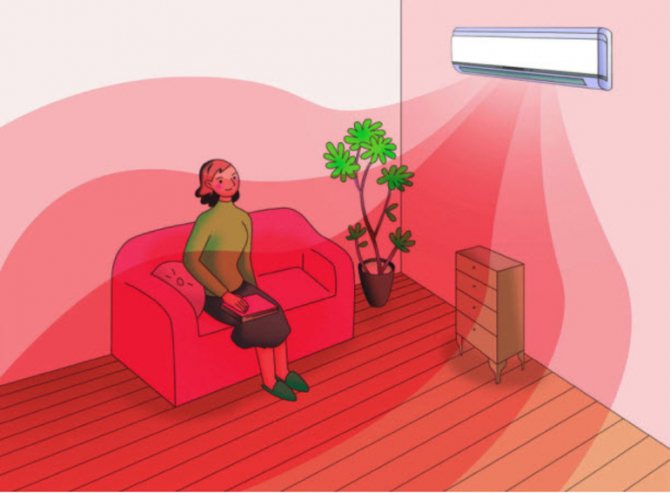
Having said that, heating a building with electrical appliances is very expensive, so purchasing an air conditioner with heating capabilities is a very smart investment. But before choosing a suitable model, you need to understand how the heating process is carried out.
The average consumer should take into account the fact that any split device is considered non-heating equipment that does not have a heating element. If the temperature values correspond to the standards declared by the manufacturer, heating occurs due to the reverse movement of the refrigerant.
Inside the outdoor unit there is a 4-way valve that starts the rotation of the working substance in the reverse order. In simple words, the functions of the evaporator and condenser are reversed. As a result of such changes, the heat exchanger begins to accept the heat of the freon and cool it, and the fan forces air masses through the condenser.
We recommend that you read: Precision air conditioner
The most popular air conditioners according to customers
Split system Mitsubishi Electric MSZ-LN25VG / MUZ-LN25VG on Yandex Market
Split system Ballu BSVP-07HN1 on Yandex Market
Split system Panasonic CS/CU-BE25TKE on Yandex Market
Split system General Climate GC/GU-EAF09HRN1 on Yandex Market
Split system Ballu BSD-09HN1 on Yandex Market
Also interesting:
Description of the operating modes of the air conditioner and icons on the remote control Water flows from the air conditioner - causes and repairs How to properly turn on and use the air conditioner Technology news: Continuing the topic: Your comment: Cancel Link to: Your comment: or log in as:
x
- Kitchen Blender
- Hood
- Grill
- Dehydrator
- Other kitchen appliances
- Coffee machine
- Kitchen stove
- Microwave
- Multicooker
- Meat grinder
- Dishwasher
- Juicer
- Thermopot
- Bread maker
- Fridge
- Electric kettle
- Boiler
- Storage water heater
- Dictaphone
- Apple iPhone
- Computer
- Irrigator
- Compressor
- Trimmer
Recent discussions of the Brest stove, only the large burner is burning
2020-07-12 15:27:12 / Ruslan The freezer is working. The refrigerator compartment is not. Where is the sensor located?
2020-07-02 06:38:45 / Dmitry The text states: “Based on the method of connecting the mug to the power supply, they are divided into devices: operating from the network with a plug...
2020-06-24 15:13:40 / Alexey
- about the project
- Contacts
© hitech-online.ru 2002-2020. Copying material is permitted only with an active hyperlink to our website! textarea>
